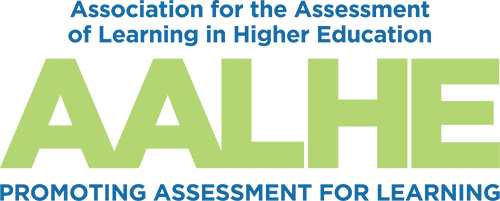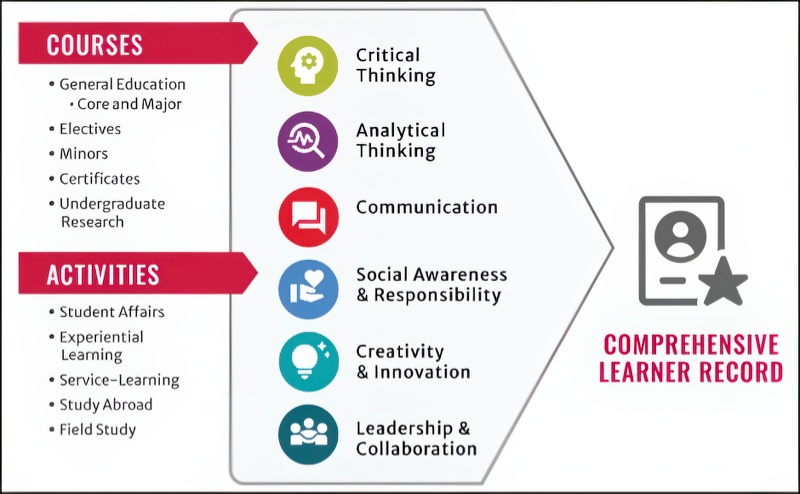- Home
- About AALHE
- Board of Directors
- Committees
- Guiding Documents
- Legal Information
- Organizational Chart
- Our Institutional Partners
- Membership Benefits
- Member Spotlight
- Contact Us
- Member Home
- Symposium
- Annual Conference
- Resources
- Publications
- Donate
EMERGING DIALOGUES IN ASSESSMENTHow Six Institutional Competencies Came to Be: A Creation Story
November 3, 2025
AbstractThis article chronicles the multi-year process undertaken by the University of Georgia (UGA) to establish a unified set of learning goals for all undergraduate students. Authored by a multi-disciplinary team of UGA administrators, the essay details the iterative development of six institutional competencies: Critical Thinking, Analytical Thinking, Communication, Social Awareness and Responsibility, Creativity and Innovation, and Leadership and Collaboration. This initiative began with a presidential task force recommendation and evolved through the synthesis of existing campus skills taxonomies, external standards like NACE and AAC&U Essential Skills, and extensive administrative working group discussions. The ultimate goal was to integrate, document, and showcase curricular and co-curricular learning through a Comprehensive Learner Record (CLR).
PrologueFor those who enjoy reading fiction - do you ever flip to the last chapter and spoil the ending of a page-turner? I admit, I do. So, I’m going to jump ahead – spoiler alert! – and reveal our six institutional competences: (1) Critical Thinking, (2) Analytical Thinking, (3) Communication, (4) Social Awareness and Responsibility, (5) Creativity and Innovation, and (6) Leadership and Collaboration. Now, back to the beginning – how did these come to be? This essay will chronicle the University of Georgia (UGA)’s journey to identifying, developing, and implementing these institution-level competencies as shared learning goals for all undergraduate students. In 2017, the University president convened a task force on student learning and success, which recommended reorienting the general education curriculum to better reflect students’ broader educational and life goals. The proposed vision emphasized interdisciplinary exploration and lifelong learning. This recommendation aligned with national trends: a NILOA (2017) survey found that most institutions had institution-wide learning statements, with many aligning program-level outcomes accordingly. [Institution] leadership supported the rationale for institution-wide undergraduate learning outcomes to shift from a fragmented academic experience to a more integrated one, linking curricular and co-curricular learning (Jankowski & Marshall, 2017). While the initial focus was on general education, the task force’s broader vision laid the groundwork for a university-wide conversation about institutional competencies. Part I: Experiential LearningFast forward to 2020. The Director of Experiential Learning (EL) at the University initiated conversations with key stakeholders about officially documenting the learning that was happening in EL. In doing so, he developed a ‘competencies taxonomy’ based on the learning outcomes associated with EL, cross-referenced with core competencies identified by the National Association of Colleges and Employers (NACE) and other college-career readiness-centered organizations. This taxonomy, as well as our institution’s existing General Education Abilities (broad cognitive skills we intended students to acquire via completion of the general education curriculum) and Student Affairs Essential Skills (cross-disciplinary skills we intended students to develop and strengthen via co-curricular learning experiences), were the first iterations of our institutional competencies. The General Education Abilities were: Written Communication, Oral Communication, Critical Thinking, Moral Reasoning, and Quantitative Reasoning. The Student Affairs Essential Skills were: Agility, Critical Thinking, Communication, Leadership & Collaboration, and Social Awareness & Responsibility (note there was already overlap!). To further develop and implement the concept, the EL director strategically convened a working group including the Office of Instruction, Assessment, Registrar’s Office, and Division of Student Affairs. It did not take long to recognize that this taxonomy captured more than just EL, and we could expand the concept to combine shared learning goals for the institution through curricular and co-curricular learning. Additionally, UGA’s Office of Instruction could officially document and verify these competencies through a Comprehensive Learner Record and a thorough and strategic assessment design. At this point, the project vision expanded, and the working group forged ahead with bold(er) goals. Part III: Institutional Competencies Working GroupThe working group convened regularly to develop and refine a set of institutional competencies with associated learning outcomes. This iterative process began with a review of existing established undergraduate learning goals at the university (e.g., General Education Abilities, Student Affairs Essential Skills, undergraduate program learning outcomes), supplemented and calibrated by a review of peer and aspirant institutions’ shared competencies, the Association and American Colleges and Universities’ (AAC&U) Essential Learning Outcomes, and NACE’s Career Readiness Competencies (see Figure 1). Figure 1. Sources that Informed the Development of UGA’s Institutional Competencies
Through conversations with the General Education subcommittee of the University Curriculum Committee, the Experiential Learning Council, Division of Student Affairs representatives, Office of Assessment, Office of Accreditation and Institutional Effectiveness, Career Center, Student Learning Outcomes Executive Committee, and leadership within the Office of Instruction, the group reviewed, discussed, and refined evolving drafts of the competencies. At this point, the group agreed upon certain skills to include unquestionably (e.g., critical thinking, communication) but had to extensively discuss several other important learning goals and the precise skillsets we aimed to capture (e.g., quantitative and analytical skills, ethical reasoning, leadership). Part IV: An Opportunity to ClarifyIn the spring of 2022 (see Figure 2), following an unsuccessful attempt to secure faculty governance approval for the proposed institutional competencies (by couching it as a simple General Education policy change, which led to confusion), the working group reconvened with many self-generated clarifying questions: WHY have a set of institutional competencies? Should we make the distinction that these are meant for undergraduate students? Are these the "right" competencies? How do we know? How do we reconcile and clarify the relationship to general education? When we imagine a student's Comprehensive Learner Record, what shows up? Assessment of competencies... how will we validate this learning? How many learning outcomes should be associated with each competency? Are the outcomes measurable? The working group engaged deeply with each of these questions. The responses were often interrelated. The hard-earned outcome was a set of revised competencies that we felt were well established, defendable, and universal across learning experiences and contexts. The table (Table 1) below offers our final list of competencies with our definition, along with behind-the-scenes commentary on their development. Figure 2. Institutional Competency Development Timeline
Table 1. Commentary on the Development of Each Competency
Part VI: Learning OutcomesTo support the mapping of courses and experiences, and to solidify the foundation for our forthcoming assessment plan, we then had to develop and revise the learning outcomes for each competency. To guide this conversation, we asked ourselves, what are the essential behaviors that define this competency? This process proved equally, if not more, time-intensive than finalizing the competencies themselves. Ultimately, we agreed that four learning outcomes per competency felt appropriate and reasonable for operationalizing the mapping schema and assessment plan. The group drew extensively from the language of multiple AAC&U VALUE rubrics, knowing they were likely to be part of our assessment design, to ensure alignment between outcome language and evaluation tool(s). Part VII: Faculty GovernanceIn spring 2023, we re-situated the proposal for institutional competencies as its own policy. The proposal included a clearer rationale for the institutional competencies, particularly why these were the most appropriate for [Institution]’s context. We had examples of course and co-curricular activities where students would develop and strengthen these competencies. We prepared thorough responses to questions about implementation and assessment. After more than eighteen months of conversation and revisions, the proposal successfully advanced through the University Curriculum Committee, Executive Committee, and University Council. To our surprise, these groups had few questions and only positive reception. We would like to think the concept of institutional competencies, as well as our thoughtful approach anticipating their questions ahead of time and proactively addressing them in the proposal, helped our colleagues agree the proposal was universally beneficial. ConclusionThe University of Georgia’s development of institutional competencies represents a collaborative, iterative, and evidence-informed approach to enhancing undergraduate education. By aligning curricular and co-curricular learning with clearly defined outcomes, the institution has laid a foundation for more integrated assessment, meaningful student reflection, and improved communication of learning to external stakeholders. This case study may serve as a model for other institutions seeking to articulate and assess shared learning goals at scale. Epilogue: The Comprehensive Learner RecordThe Comprehensive Learner Record (CLR) serves as a tangible extension of our institutional competencies, translating learning outcomes into demonstrable achievements. UGA’s Office of Instruction now invites campus units to submit approval requests for courses and activities that align with competencies. Note: There is no requirement for students to complete specific competencies, nor are academic units mandated to align offerings with them. The Institutional Competency Committee, a subcommittee of the University Curriculum Committee, began convening in Fall 2024 to approve such requests. Once approved, courses that map to institutional competencies will display on students’ Comprehensive Learner Record (CLR). The CLR is a digital tool that offers a holistic summary of student learning and helps students communicate the knowledge and skills gained due to their cumulative educational experience (see Figure 3). By capturing both curricular and co-curricular experiences, the CLR allows UGA to recognize, validate, and showcase for students the full scope of their learning in alignment with our competency framework. Figure 3. Visual Concept for UGA’s Comprehensive Learner Record
ReferencesJankowski, N. A., & Marshall, D. W. (2017). Degrees that matter: Moving higher education to a learning systems paradigm. Stylus Publishing. National Institute for Learning Outcomes Assessment (NILOA). (2017). Higher education quality: Why documenting learning matters. University of Illinois and Indiana University, Urbana-Champaign. https://www.learningoutcomesassessment.org Association of American Colleges and Universities. (n.d.) VALUE rubrics. https://www.aacu.org/value-rubrics |




